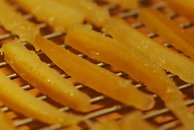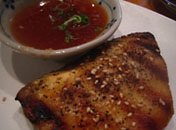Selection and storage
Tangerines are winter-season fruits. However, one may find them in supermarkets all around the year, thanks to advanced storage technologies. Buy fresh fruits featuring bright orange color and feel heavy in hand. Avoid fruits with spots, excessively softened, or feel “hollow” in hand.
Commercially, citrus fruits are washed and waxed to extend their shelf-life, appearance, and market value. It is safe to use them. However, choose carefully, since oftentimes their defects may be disguised by wax.
Once at home, store them in a zip pouch and place them inside the refrigerator where they keep well for up to a week. However, eat as early as possible to enjoy their rich flavor and nutrition benefits.
Preparation and serving methods
Tangerines come with natural peel, which makes their edible arils well-preserved from contamination. Just clean with a moist absorbent cloth to remove any surface dirt and wax. Peel the skin with your hands, remove the pith, and separate segments. Seedless Mandarine/ Clementine segments can be readily eaten.
Just as in other citrus fruits, squeeze the seeds out after making a small snip on the inner side of the aril at its center. Although it is harmless to eat seeds, their bitter taste makes them inedible.
Here are some Serving tips:

|

|
| Candied orange peels. Courtesy: grongar | Ponzu sauce over grilled mackerel. Courtesy: Rick |
-
As in oranges, tangerines can be eaten on their own without any additions.
-
Tangerine juice is a healthy refreshing drink. It is employed in syrups, sauces, marinades, concentration, etc.
-
Its juicy segments add richness to fruit/green salads.
-
Tangerine zest imparts distinctive orange flavor to confectionary items such as biscuits, cakes, muffins, pastry cream, ice creams, etc.
-
Yuzu juice and its zest is an essential ingredient in traditional Japanese cuisines such as ponzu sauce and ponzu shoyu (with soy sauce), with fish as a marinade.
-
Its skin (pericarp) can be candied as in oranges.
Safety profile
Insecticide sprays are applied widely over citrus crops. Therefore, it is recommended to wash the fruits in cold running water before use.
Organic fruits are devoid of these chemicals and are best suited for zest preparation. (Medical disclaimer).
≺≺ Back to Fruits from Tangerines. Visit here for an impressive list of all varieties of fruits with complete illustrations of their nutrition facts and health benefits.
≺≺ Back to Home page.
Further reading and Resources:
-
Stanford School of Medicine Cancer information Page- Nutrition to Reduce Cancer Risk.
-
JN-The Journal of nutrition– The Hypoglycemic Effects of Hesperidin and Naringin Are Partly Mediated by Hepatic Glucose-Regulating Enzymes in C57BL/KsJ-db/db Mice.

